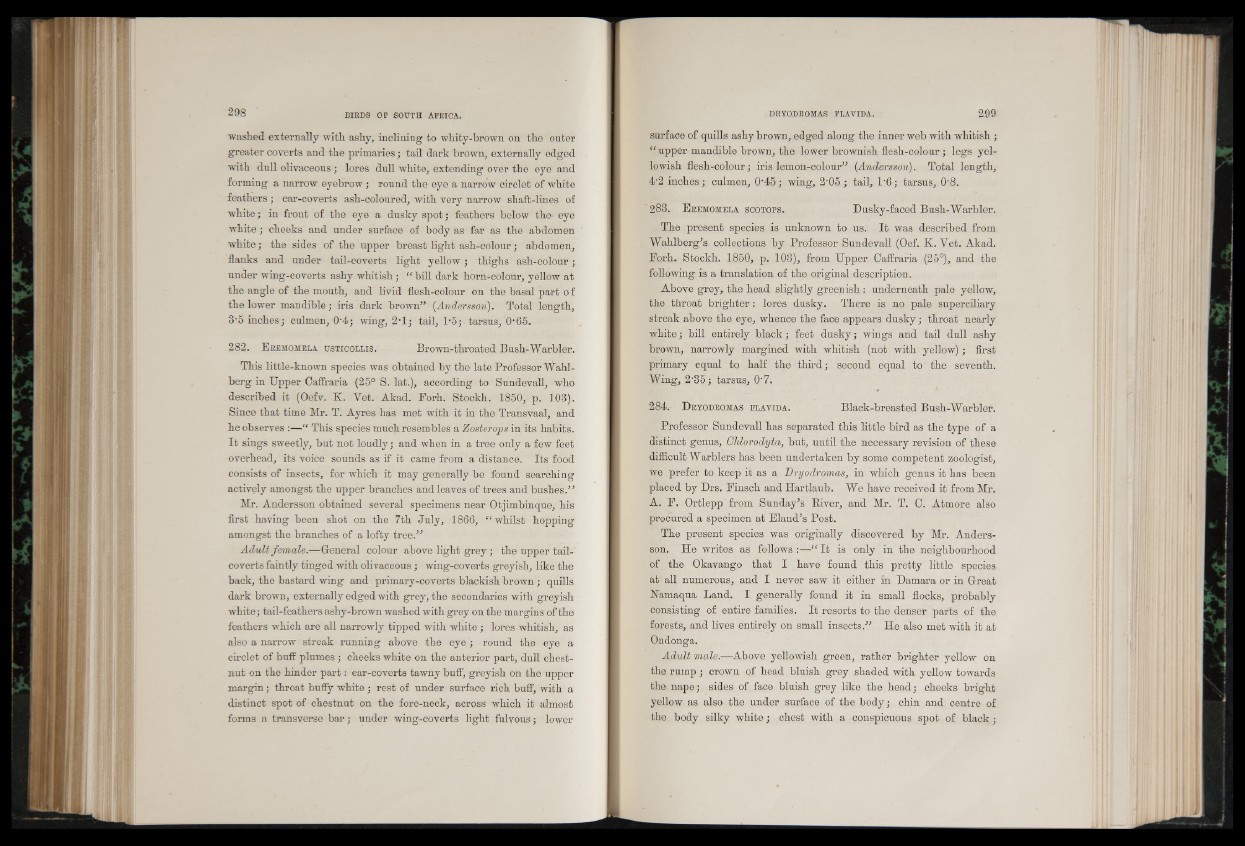
washed externally with ashy, inclining to whity-brown on the outer
greater coverts and the primaries; tail dark brown, externally edged
with dull olivaceous; lores dull white, extending over the eye and
forming a narrow eyebrow ; round the eye a narrow circlet of white
feathers; ear-coverts ash-coloured, with very narrow shaft-lines of
white; in front of the eye a dusky spot; feathers below the* eye
white; cheeks and under surface of body as far as the abdomen
white; the sides of the upper breast light ash-colour; abdomen,
flanks and under tail-coverts light yellow; thighs ash-colour ;
under wing-coverts ashy whitish; “ bill dark horn-colour, yellow at
the angle of the mouth, and livid flesh-colour on the basal part of
the lower mandible; iris dark brown” (Andersson). Total length,
3-5 inches; culmen, 0'4; wing, 2T; tail, 1*5; tarsus, 0-65.
282. E rjemomela u st ico l l is . Brown-throated Bush-Warbler.
This little-known species was obtained by the late Professor Wahl-
berg in Upper Caffraria (25° S. lat.), according to Sundevall, who
described it (Oefv. K. Yet. Akad. Fork. Stockh. 1850, p. 103).
Since that time Mr. T. Ayres has met with it in the Transvaal, and
he observes :—“ This species much resembles a Zoster ops in its habits.
It sings sweetly, but not loudly; and when in a tree only a few feet
overhead, its voice sounds as if it came from a distance. Its food
consists of insects, for which it may generally be found searching
actively amongst the upper branches and leaves of trees and bushes.”
Mr. Andersson obtained several specimens near Otjimbinque, his
first having been shot on the 7th July, 1866, “ whilst hopping
amongst the branches of a lofty tree.”
Adult female.—General colour above light grey ; the upper tail-
coverts faintly tinged with olivaceous; wing-coverts greyish, like the
back, the bastard wing and primary-coverts blackish brown ; quills
dark brown, externally edged with grey, the secondaries with greyish
white; tail-feathers ashy-brown washed with grey on the margins of the
feathers which are all narrowly tipped with white ; lores whitish, as
also a narrow streak running above the eye ; round the eye a
circlet of buff plumes; cheeks white on the anterior part, dull chestnut
on the hinder p a rt: ear-coverts tawny buff, greyish on the upper
margin; throat buffy white; rest of under surface rich buff, with a
distinct spot of chestnut on the fore-neck, across which it almost
forms a transverse bar; under wing-coverts light fulvous; lower
surface of quills ashy brown, edged along the inner web with whitish ;
“ upper mandible brown, the lower brownish flesh-colour ; legs yellowish
flesh-colour; iris lemon-colour” (Andersson). Total length,
4'2 inches; culmen, 0’45; wing, 2-05; tail, 1‘6 ; tarsus, 0-8.
283. E remomela scotops. Dusky-faced Bush-Warbler.
The present species is unknown to us. It was described from
Wahlberg’s collections by Professor Sundevall (Oef. K. Yet. Akad.
Forh. Stockh. 1850, p. 103), from Upper Caffraria (25°), and the
following is a translation of the original description.
Above grey, the head slightly greenish: underneath pale yellow,
the throat brighter: lores dusky. There is no pale superciliary
streak above the eye, whence the face appears dusky; throat nearly
white; bill entirely black; feet dusky; wings and tail dull ashy
brown, narrowly margined with whitish (not with yellow); first
primary equal to half the third; second equal to' the seventh.
Wing, 2-35; tarsus, 0'7.
284. D ryodromas e lav id a . Black-breasted Bush-Warbler.
Professor Sundevall has separated this little bird as the type of a
distinct genus, Ghlorodyta, but, until the necessary revision of these
difficult Warblers has been undertaken by some competent zoologist,
We prefer to keep it as a Dryodromas, in which genus it has been
placed by Drs. Finsch and Hartlaub. We have received it from Mr.
A. F. Ortlepp from Sunday’s River, and Mr. T. C. Atmore also
procured a specimen at Eland’s Post.
The present species was originally discovered by Mr. Andersson.
He writes as follows :—“ It is only in the neighbourhood
of the Okavango that I have found this pretty little species
at all numerous, and I never saw it either in Damara or in Great
Namaqua Land. I generally found it in small flocks, probably
consisting of entire families. It resorts to the denser parts of the
forests, and lives entirely on small insects.” He also met with it at
Ondonga.
Adult male.i—Above yellowish green, rather brighter yellow on
the rump ; crown Qf head bluish grey shaded with yellow towards
the nape; sides of face bluish grey like the head; cheeks bright
yellow as also the under surface of the body; chin and centre of
the body silky white; chest with a conspicuous spot of black;